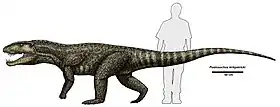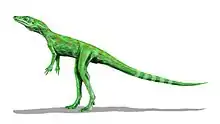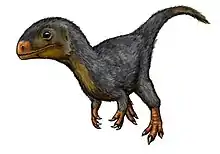The Chinle Formation is an Upper Triassic continental geologic formation in the western United States which has yielded fossils of many archosaurs: a group of vertebrates that includes crocodiles, pterosaurs, dinosaurs (including birds), and other extinct relatives. This is a list of all archosaurs from the formation, including suchians (crocodilian relatives) and avemetatarsalians (dinosaurs, pterosaurs, and their relatives), as well as the abundant crocodilian-like phytosaurs, which may either be true archosaurs or very close relatives of Archosauria.
Phytosaurs
| Phytosaurs of the Chinle Formation | ||||||
|---|---|---|---|---|---|---|
| Genus | Species | State | Member | Abundance | Notes | Images |
|
L. crosbiensis[1] |
|
|||||
|
S. adamanensis[1] |
|
Known from a single skull |
Previously referred to Leptosuchus, actually referable to Smilosuchus.[3] | |||
|
S. gregorii |
|
|
Known from a handful of skulls. |
A basal leptosuchomorph. | ||
|
S. lithodendrorum[3] |
|
|
Known from only one skull. |
Previously considered synonymous with S. adamanensis. | ||
|
cf. Paleorhinus[4] |
Indeterminate[4] |
|
|
|||
|
M. buceros[5] |
|
|||||
|
M. mccauleyi[5] |
|
|||||
|
M. pristinus[5] |
|
|||||
| Pravusuchus[3] | P. hortus |
|
|
Three skulls. | A leptosuchomorph phytosaur closely related to Mystriosuchini[3][6] or Nicrosaurus.[7] | |
| Protome[8] | P. batalaria |
|
|
Partial skull and jaw. | A phytosaur originally described as a juvenile Leptosuchus, but probably an unrelated non-leptosuchomorph[8] or mystriosuchin.[7] | |
|
R. gregorii[9] |
A large late-surviving mystriosuchin phytosaur closely related to Machaeroprosopus (formerly known as Pseudopalatus),[10] and often considered a subgenus of that taxon.[2][6][7] | |||||
Suchians
Aetosaurs
Color key
|
Notes Uncertain or tentative taxa are in small text; |
| Aetosaurs of the Chinle Formation | ||||||
|---|---|---|---|---|---|---|
| Genus | Species | State | Member | Abundance | Notes | Images |
| Adamanasuchus | A. eisenhardtae |
|
|
Osteoderms and skull and postcranial fragments. | A basal desmatosuchine related to Calyptosuchus and Scutarx.[11] | |
|
C. wellesi[13] |
|
|
Common, although "non-armor material is comparatively rare".[13] |
A basal desmatosuchine originally considered a species of Stagonolepis. | ||
|
D. spurensis[15] |
|
|
Numerous osteoderms and other skeletal material | A large desmatosuchin which was fairly common in the lower part of the Chinle Formation. Prior to 2008, fossils of D. spurensis were listed as the species D. haplocerus, until it was determined that D. haplocerus was a species name originally based on undiagnostic fossils.[11] | ||
|
D. smalli[16] |
|
|
A single lateral osteoderm. | A desmatosuchin which is very rare in the Chinle Formation. One of the youngest known occurrences of the genus Desmatosuchus.[11] | ||
|
P. andressorum[17] |
|
|
Osteoderms |
A significant number of researchers feel that the North American material referred to the German Paratypothorax species P. andressorum by Hunt and Lucas in 1992 is actually distinct.[17] | ||
|
Indeterminate[18] |
|
Osteoderms and minor postcranial fragments. | A paratypothoracin typothoracine known from isolated material similar to more complete specimens from Germany.[19] | |||
|
R. chamaensis |
|
Osteoderms and possible ankle and vertebrae remains. |
A late-surviving paratypothoracin typothoracine. Originally referred to Desmatosuchus, but later reinterpreted as a relative of Paratypothorax based on a phylogenetic analysis performed on the remains by Parker in 2003.[20] New genus names were erected independently by Parker (coining the name Heliocanthus) and Lucas et al. (coining the name Rioarribasuchus), prompting an investigation into reports of unethical taxonomic claim-jumping. | |||
| Scutarx[11] | S. deltatylus[11] |
|
|
Four partial skeletons including skull fragments. | A large basal desmatosuchine based on fossils originally referred to "Stagonolepis" (=Calyptosuchus) wellesi, a close relative. Fossils of Scutarx represent the highest stratigraphic occurrence of Stagonolepis-like aetosaurs in Petrified Forest National Park. | |
| Stenomyti | S. huangae |
|
|
Partial skeleton including a well-preserved skull. | A small aetosaurine similar to Aetosaurus. | |
|
T. coccinarum[21] |
|
Common in the Owl Rock and Petrified Forest Members.[21] |
A large, wide-bodied typothoracine abundant throughout the Chinle Formation. Almost all of the known Chinlean Typothorax fossils are isolated whole or fragmentary osteoderms.[21] | |||
| Tecovasuchus[22] | T. chatterjeei |
|
|
Osteoderms. | Previously thought to be more widespread in the formation.[22] | |
| Kryphioparma[22] | K. caerula |
|
|
Osteoderms. | Described in 2023, probably related to other typothoracines.[22] | |
Crocodylomorphs
| Crocodylomorphs of the Chinle Formation | ||||||
|---|---|---|---|---|---|---|
| Genus | Species | State | Member | Abundance | Notes | Images |
|
H. agilis[23] |
|
| ||||
|
P. mccreai[24] |
|
|||||
Other paracrocodylomorphs
| Paracrocodylomorphs of the Chinle Formation | ||||||
|---|---|---|---|---|---|---|
| Genus | Species | State | Member | Abundance | Notes | Images |
|
E. okeeffeae |
|
|
A six-foot-long shuvosaurid from the Coelophysis quarry of Ghost Ranch. |
| ||
|
P. gracilis[25] |
|
|||||
|
P. kirkpatricki[26] |
|
|||||
|
Indeterminate[27] |
|
|
Jaw fragment. |
Identified from a fossil which has been reinterpreted as an indeterminate "rauisuchian". | ||
|
S. inexpectatus[28] |
|
|||||
|
V. haydeni[29] |
|
|
A large rauisuchid similar to Postosuchus. | |||
Other suchians
| Miscellaneous suchians of the Chinle Formation | ||||||
|---|---|---|---|---|---|---|
| Genus | Species | State | Member | Abundance | Notes | Images |
| Acaenasuchus[30] | A. geoffreyi[30] |
|
Known from a handful of isolated osteoderms.[30] | A controversial suchian based primarily on osteoderms. Some paleontologists have considered Acaenasuchus to be juvenile Desmatosuchus haplocerus scutes, while others considered it a separate genus of small aetosaurs.[30] Most recently it has been reconsidered an aetosauriform related to, but not within, Aetosauria. It is also related to Revueltosaurus (also from the Chinle) and the armored reptile Euscolosuchus from Virginia.[31] | ||
|
R. callenderi[33] |
|
|
||||
|
R. hunti[34] |
|
|
||||
Avemetatarsalians
Basal avemetatarsalians
Color key
|
Notes Uncertain or tentative taxa are in small text; |
| Basal Dinosauriforms of the Chinle Formation | ||||||
|---|---|---|---|---|---|---|
| Genus | Species | State | Member | Abundance | Notes | Images |
| Dromomeron | D. romeri |
|
|
A lagerpetid pterosauromorph found at various Ghost Ranch quarries and elsewhere in the Chinle Formation. |
| |
|
E. baldwini |
|
|
A silesaurid dinosauriform closely related to the Polish genus Silesaurus.[36] | |||
|
K. williamparkeri |
|
|
A silesaurid dinosauriform with adaptations for herbivory. | |||
Dinosaurs
Sauropodomorphs
Prosauropod tracks are present in the Redonda, Sloan Canyon, and Sheep Pen Sandstone formations. Possibly the Rock Point Formation as well. Geographically, the tracks are present in New Mexico.[35]
Theropods and near-relatives
Theropod tracks have been found in Utah and New Mexico recovered from the Redonda, Sloan Canyon, and Sheep Pen Sandstone formations.[35] Indeterminate theropod remains are stratigraphically present in the Petrified Forest, Bluewater Creek, and Rock Point members of New Mexico.[35]
| Theropods and near-relatives of the Chinle Formation | ||||||
|---|---|---|---|---|---|---|
| Genus | Species | State | Member | Abundance | Notes | Images |
|
C. arizonensis[35] |
|
|
A coelophysine coelophysid |
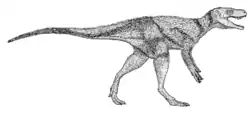 Chindesaurus bryansmalli (interpreted as a herrerasaurid) | ||
|
C. bryansmalli[35] |
|
|
A large saurischian alternatively considered a herrerasaurid or a theropod related to Tawa hallae. | |||
|
C. bauri |
|
|
||||
| C. sp.[39] |
|
|
Originally assigned to C. bauri, but likely a different taxon.[39] | |||
|
C. longicollis[35] |
|
|
Now considered a junior synonym of C. bauri. | |||
|
C. willistoni |
|
|
Now considered a junior synonym of C. bauri. | |||
|
D. chauliodus |
|
|
Skull and neck vertebrae fragments | A possible basal theropod with a short skull and enlarged teeth. | ||
|
T. hallae |
|
|
A probable basal theropod showing a mosaic of features similar to neotheropods and herrerasaurids. | |||
See also
Footnotes
- 1 2 3 4 5 6 7 8 9 10 11 "Vertebrate Fauna; Parasuchia; Leptosuchus adamanensis, L. crosbiensis, and L. gregorii," Irmis (2005) p. 72, 74
- 1 2 3 4 5 6 7 Long, R.A. and Murray, P.A. 1995. Late Triassic (Carnian and Norian) Tetrapods from the Southwestern United States. New Mexico Museum of Natural History and Science Bulletin 4. pp. 254.
- 1 2 3 4 Stocker, Michelle R. (2010-09-01). "A new taxon of phytosaur (Archosauria: Pseudosuchia) from the Late Triassic (Norian) Sonsela Member (Chinle Formation) in Arizona, and a critical reevaluation of Leptosuchus Case, 1922". Palaeontology. 53 (5): 997–1022. doi:10.1111/j.1475-4983.2010.00983.x. ISSN 1475-4983. S2CID 83536253.
- 1 2 3 4 "Vertebrate Fauna; Parasuchia; 'Paleorhinus sp.'" Irmis (2005) p. 72
- 1 2 3 4 5 6 7 8 9 10 11 12 13 14 15 16 "Vertebrate Fauna; Parasuchia; Pseudopalatus pristinus, P. buceros, and P. mccauleyi," Irmis (2005) p. 74-75
- 1 2 Christian F. Kammerer; Richard J. Butler; Saswati Bandyopadhyay; Michelle R. Stocker (2016). "Relationships of the Indian phytosaur Parasuchus hislopi Lydekker, 1885" (PDF). Papers in Palaeontology. 2 (1): 1–23. doi:10.1002/spp2.1022. S2CID 83780331.
- 1 2 3 Jones, Andrew S.; Butler, Richard J. (2018-12-10). "A new phylogenetic analysis of Phytosauria (Archosauria: Pseudosuchia) with the application of continuous and geometric morphometric character coding". PeerJ. 6: e5901. doi:10.7717/peerj.5901. ISSN 2167-8359. PMC 6292387. PMID 30581656.
- 1 2 Stocker, M. R. (2012). "A new phytosaur (Archosauriformes, Phytosauria) from the Lot's Wife beds (Sonsela Member) within the Chinle Formation (Upper Triassic) of Petrified Forest National Park, Arizona". Journal of Vertebrate Paleontology. 32 (3): 573–586. doi:10.1080/02724634.2012.649815. S2CID 129527672.
- 1 2 Hunt, A.P. and Lucas, S.G. 1993. A new phytosaur (Reptilia: Archosauria) genus from the uppermost Triassic of the western United States and its biochronological significance. In; The Nonmarine Triassic, Lucas and Morales, eds., New Mexico Museum of Natural History and Science Bulletin 3.
- ↑ Hungerbühler A. 2002. The Late Triassic phytosaur Mystriosuchus westphali, with a revision of the genus. Palaeontology 45 (2): 377-418
- 1 2 3 4 5 6 7 8 9 Parker, William G. (2016-01-21). "Revised phylogenetic analysis of the Aetosauria (Archosauria: Pseudosuchia); assessing the effects of incongruent morphological character sets". PeerJ. 4: e1583. doi:10.7717/peerj.1583. ISSN 2167-8359. PMC 4727975. PMID 26819845.
- ↑ "Vertebrate Fauna; Stagonolepididae," Irmis (2005) p. 77
- 1 2 3 4 "Vertebrate Fauna; Stagonolepididae; Stagonolepis wellesi," Irmis (2005) p. 77
- ↑ "Vertebrate Fauna; Stagonolepididae," Irmis (2005) p. 75
- 1 2 3 "Vertebrate Fauna; Stagonolepididae; Desmatosuchus haplocerus," Irmis (2005) p. 75
- 1 2 "Vertebrate Fauna; Stagonolepididae; Desmatosuchus smalli," Irmis (2005) p. 75
- 1 2 3 4 "Vertebrate Fauna; Stagonolepididae; Paratypothorax sp.," Irmis (2005) p. 78
- 1 2 3 "Vertebrate Fauna; Stagonolepididae; 'Paratypothorax sp.' and 'Paratypothorax-Like Forms'," Irmis (2005) p. 78
- ↑ Parker, William G.; Martz, Jeffrey W. (2010). "The Late Triassic (Norian) Adamanian–Revueltian tetrapod faunal transition in the Chinle Formation of Petrified Forest National Park, Arizona". Earth and Environmental Science Transactions of the Royal Society of Edinburgh. 101 (3–4): 231–260. doi:10.1017/S1755691011020020. ISSN 1755-6910. S2CID 140536630.
- 1 2 3 4 "Vertebrate Fauna; Stagonolepididae; "Desmatosuchus" chamaensis," Irmis (2005) p. 75
- 1 2 3 4 5 6 7 8 "Vertebrate Fauna; Stagonolepididae; Typothorax coccinarum," Irmis (2005) pp. 77-78
- 1 2 3 4 Reyes, William A.; Parker, William G.; Heckert, Andrew B. (2023), "A new aetosaur (Archosauria: Pseudosuchia) from the upper Blue Mesa Member (Adamanian: Early–Mid Norian) of the Late Triassic Chinle Formation, northern Arizona, USA, and a review of the paratypothoracin Tecovasuchus across the southwestern USA", PaleoBios, 40 (9), doi:10.5070/P940961559, S2CID 259972056
- 1 2 3 4 5 6 "Vertebrate Fauna; Crocodylomorpha; Hesperosuchus agilis," Irmis (2005) pp. 79-80
- 1 2 3 4 5 "Vertebrate Fauna; Crocodylomorpha; 'Parrishia mccreai,'" Irmis (2005) pp. 80-81
- 1 2 3 4 5 "Vertebrate Fauna; Poposauridae; Poposaurus gracilis," Irmis (2005) p. 79
- 1 2 3 4 5 6 7 8 "Vertebrate Fauna; 'Rauisuchidae'; Postosuchus kirkpatricki," Irmis (2005) p. 78
- 1 2 3 4 "Vertebrate Fauna; 'Rauisuchidae'; 'Saurosuchus sp.,'" Irmis (2005) p. 78
- 1 2 3 4 5 6 "Vertebrate Fauna; Poposauridae; 'Chatterjeea elegans,'" Irmis (2005) p. 79
- 1 2 3 4 Emily J. Lessner; Michelle R. Stocker; Nathan D. Smith; Alan H. Turner; Randall B. Irmis; Sterling J. Nesbitt (2016). "A new rauisuchid (Archosauria, Pseudosuchia) from the Upper Triassic (Norian) of New Mexico increases the diversity and temporal range of the clade". PeerJ. 4: e2336. doi:10.7717/peerj.2336.
- 1 2 3 4 5 6 7 8 "Vertebrate Fauna; Stagonolepididae; Acaenasuchus geoffreyi," Irmis (2005) pp. 75-77
- ↑ Marsh, Adam D.; Smith, Matthew E.; Parker, William G.; Irmis, Randall B.; Kligman, Ben T. (2020-10-12). "Skeletal Anatomy of Acaenasuchus Geoffreyi Long and Murry, 1995 (Archosauria: Pseudosuchia) and its Implications for the Origin of the Aetosaurian Carapace". Journal of Vertebrate Paleontology. 40 (4): e1794885. doi:10.1080/02724634.2020.1794885. hdl:10919/102375. ISSN 0272-4634.
- ↑ "Vertebrate Fauna; Pseudosuchia; 'Revueltosaurus callenderi' and 'Revueltosaurus hunti,'" Irmis (2005) pp. 71-72
- 1 2 3 "Vertebrate Fauna; Pseudosuchia; Revueltosaurus callenderi," Irmis (2005) pp. 71-72
- 1 2 3 "Vertebrate Fauna; Pseudosuchia; Revueltosaurus hunti," Irmis (2005) p. 72
- 1 2 3 4 5 6 7 8 9 10 11 12 13 14 15 16 17 18 19 Weishampel, David B; et al. (2004). "Dinosaur distribution (Late Triassic, North America)." In: Weishampel, David B.; Dodson, Peter; and Osmólska, Halszka (eds.): The Dinosauria, 2nd, Berkeley: University of California Press. Pp. 518–521. ISBN 0-520-24209-2.
- ↑ See Nesbitt et al. (2005) and Ezcurra (2006).
- ↑ Jeffrey W. Martz; Bryan J. Small (2019). "Non-dinosaurian dinosauromorphs from the Chinle Formation (Upper Triassic) of the Eagle Basin, northern Colorado: Dromomeron romeri (Lagerpetidae) and a new taxon, Kwanasaurus williamparkeri (Silesauridae)". PeerJ. 7: e7551. doi:10.7717/peerj.7551. PMC 6730537. PMID 31534843.
- 1 2 Zeigler, K. E.; Kelley, S.; Geissman, J. W. (2008). "Revisions to stratigraphic nomenclature of the Upper Triassic Chinle Group in New Mexico: New insights from geologic mapping, sedimentology, and magnetostratigraphic/paleomagnetic data". Rocky Mountain Geology. 43 (2): 121–141. doi:10.2113/gsrocky.43.2.121.
- 1 2 3 4 "Vertebrate Fauna; Pseudosuchia; Revueltosaurus callenderi," Irmis (2005) p. 81
References
- Ezcurra, M.D. (2006). "A review of the systematic position of the dinosauriform archosaur Eucoelophysis baldwini Sullivan & Lucas, 1999 from the Upper Triassic of New Mexico, USA." Geodiversitas, 28(4):649-684.
- Irmis, R. B. 2005. The vertebrate fauna of the Upper Triassic Chinle Formation in northern Arizona. p. 63-88. in S.J. Nesbitt, W.G. Parker, and R.B. Irmis (eds.) 2005. Guidebook to the Triassic formations of the Colorado Plateau in northern Arizona: Geology, Paleontology, and History. Mesa Southwest Museum Bulletin 9.
- Nesbitt, S.J., Irmis, R.B., and Parker, W.G. (2005). "A critical review of the Triassic North American dinosaur record." In Kellner, A.W.A., Henriques, D.D.R., & Rodrigues, T. (eds.), II Congresso Latino-Americano de Paleontologia de Vertebrados, Boletim de Resumos. Rio de Janeiro: Museum Nacional/UFRJ, 139.
- Sues, H.-D., Nesbitt, S. J., Berman, D. S., and A. C., Henrici. 2011. A late-surviving basal theropod dinosaur from the latest Triassic of North America. Proceedings of the Royal Society B. doi:10.1098/rspb.2011.0410
- Weishampel, David B.; Dodson, Peter; and Osmólska, Halszka (eds.): The Dinosauria, 2nd, Berkeley: University of California Press. 861 pp. ISBN 0-520-24209-2.



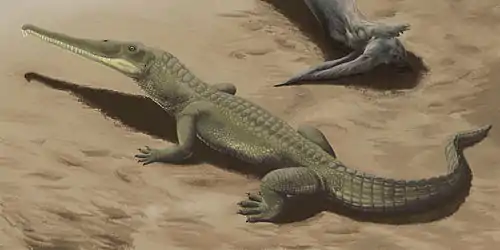
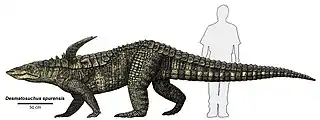
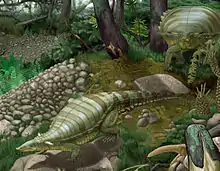


.jpg.webp)
